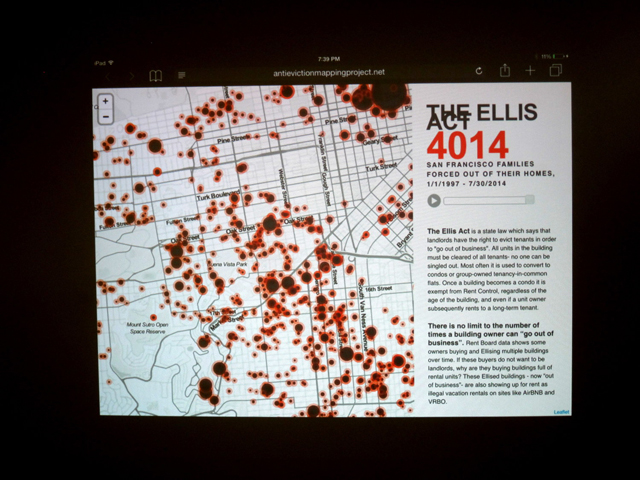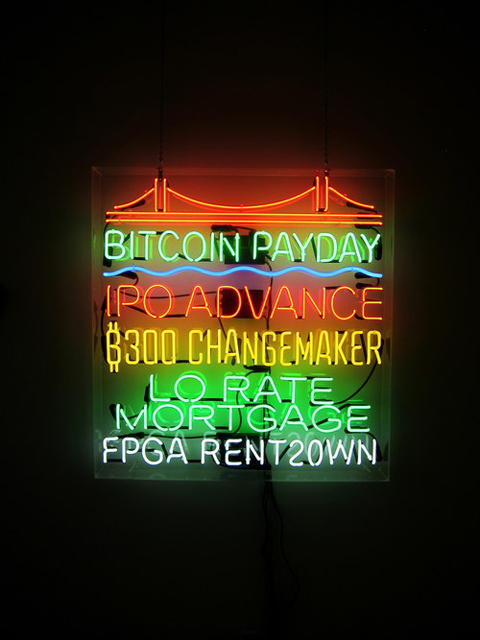In the Bay Area, one can hardly read the news — or walk a city block — without bumping into the topic of gentrification. An exhibition curated by Dorothy Santos, The Dissidents, the Displaced, and the Outliers presents a group of local artists whose work addresses this issue, along with its somewhat unexpected connection to surveillance.
The decision to split the show between San Francisco’s Incline Gallery and Oakland’s Random Parts is timely; this year, Oakland surpassed San Francisco for the second fastest rent increase in the country. In nuanced approaches to the Bay Area’s most pressing and complicated issues, the artists of The Dissidents remind us that the relationship between technology, power and society remains multifaceted.
At Random Parts, COLL.EO’s City Blocks (2014) mimic children’s building blocks, yet depict images of people sleeping on sidewalks and urinating in public. These potentially invasive photographs are complicated at times by the shadow of a Google Street View car and the marks of a browser’s interface, virtual directional arrows and location stamps. Left implicit is the suggestion that homelessness is a possible consequence of the very technology capturing its likeness.

Shown in both venues, interactive info graphics by the Anti-Eviction Mapping Project visualize data of no-fault evictions from 1997 to 2014. Projected on a wall, a map of San Francisco explodes in red and purple dots, rapidly increasing in the most recent years. The info graphics are engaging and sobering, a presentation of facts in an emotionally charged arena.
Similarly, the work of Eliza Barrios serves up practical information through Quick Response (QR) codes in two site-specific installations. When scanned with a smartphone equipped with the proper app, Barrios’ codes link to YouTube videos, TED talks and news articles related to gentrification in the Bay Area, including the viral video from Buzzfeed, “What It’s Like To Lose Your Home To Gentrification.”
QR codes are used primarily for contemporary advertising, albeit targeted to a moneyed demographic with access to pricey smart phones. Barrios invokes this irony without flinching, proposing that while the social impact of technology merits critique, one needn’t abandon devices entirely.

Another artist in the exhibition takes on technology and advertising by employing a more analog medium. Tom Loughlin’s neon signs at both galleries satirically comment on the changing economy of the Bay Area. In pinks, greens and yellows, text like “Bitcoin Pay Day” and “IPO Advance” mirror the neon signs found at pawn shops and money order locations in low-income areas. Loughlin’s decision to mimic this aesthetic suggests a new public is replacing the poorer populous: the wealthy tech elite.
Leslie Dreyer interacts directly with this demographic in her 2014 performance Reclaim Disrupt. Video documentation at Incline Gallery shows the artist hawking bricks to attendees of a tech conference titled “DISRUPT.” The bricks, repurposed from a demolition site, bear engraved dedications to evicted families. With each potential buyer, a straight-faced Dreyer describes a pricing schema based on one’s salary, assets and relationship to eviction (half price for those who have faced eviction).
At both galleries, Elizabeth Travelslight’s quilts echo COLL.EO’s distortion of familiar objects. Sewn alongside flannel and fleece are strips of bulletproof material, infrared surveillance-blocking Mylar and a custom-printed fabric depicting the remnants of Edward Snowden’s dismantled computer. Travelslight presents an object of comfort as an illusion of safety and privacy. What figurative security blankets do we continue to wrap ourselves in?
The Dissidents is more than a collection of facts to learn. These local artists, addressing issues of pressing local concern with some of the most interesting practices in the Bay Area, are proof that dissent is alive and well. The exhibition itself stays complicated; artworks overlap and interlock and it takes some work to figure out how everything fits together. When examining how power shifts across economies during times of change, simple answers don’t necessarily exist. The Dissidents attests to this challenge. Whatever direction the Bay Area heads, these artworks are evidence of a population that won’t be silenced.
The Dissidents, the Displaced, and the Outliers is on view through Jun. 5, 2015 at Random Parts in Oakland, and through Jun. 19, 2015 at Incline Gallery in San Francisco.